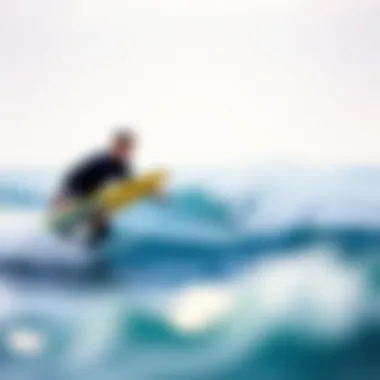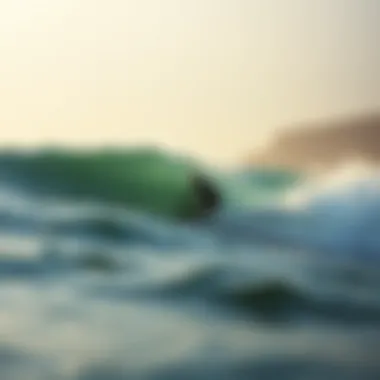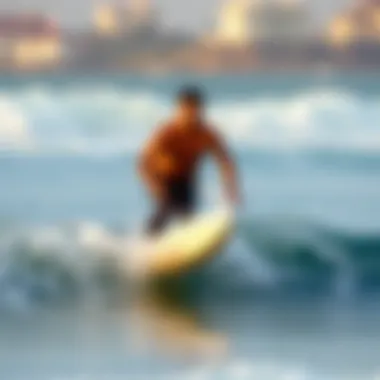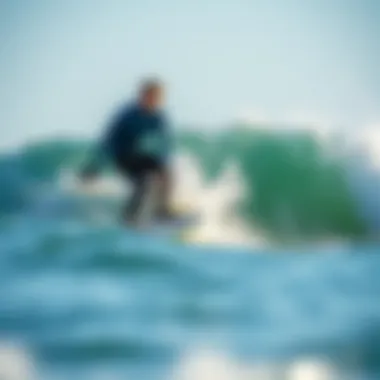Understanding Rip Tide Watch: Safety in Ocean Currents


Intro
Rip tides are a formidable force in ocean currents, frequently posing a danger to surfers and casual beachgoers alike. They can pull even the strongest swimmers into deeper waters with alarming speed and power. Understanding rip tide dynamics is essential for anyone venturing into the ocean. This knowledge becomes pivotal not just for personal safety but also for enhancing the overall surf culture by promoting responsible behavior in natural waters.
Before heading out, it’s crucial to comprehend how these currents form and the risks they present, particularly during different times of the day or under changing weather conditions. This piece aims to shed light on what one can do in the face of a rip tide warning and the available gear to boost safety on your ocean outings.
With insights into essential equipment, proactive safety strategies, and proper surfing techniques, enthusiasts are encouraged to remain well-informed and prepared. The joy of riding waves should never be overshadowed by the unpredictability of the ocean, and maintaining awareness of conditions that could lead to dangerous rip tides is key. So, let’s unravel this critical topic so that ocean lovers can navigate their surf experiences with confidence and knowledge.
The Nature of Rip Tides
Rip tides, often erroneously termed rip currents, are significant to ocean safety, especially for surfers and beachgoers alike. Understanding their dynamics is vital. These currents, while fascinating, pose real dangers, making it essential to grasp their nature and behavior before entering the water. This section serves as a foundation, educating our audience on not just what rip tides are, but how they manifest.
Defining Rip Tides
Rip tides are narrow channels of fast-moving water that flow away from the shore, typically caused by water returning to the sea after being pushed inland by waves. They can form in varying coastal environments, and their characteristics can change significantly based on local conditions. The confusion between rip tides and rip currents is common. In reality, they share a relationship; rip tides are tied to the freshly created rip currents.
Formation Mechanisms
Understanding how rip tides form is the backbone of ocean safety education.
Wave Refraction
Wave refraction plays a crucial role in the creation of rip tides. As waves approach the shore, they bend based on the underwater topography. This can cause some areas to accumulate excess water as waves break. The water then seeks to return to the ocean. A key feature of wave refraction is its dependency on the angle of the incoming waves—it can increase the strength of rip currents significantly. This understanding is beneficial here because recognizing the conditions under which waves refract helps forecast potential rip tide formations. However, its intricate nature can make predicting rip currents tricky for the untrained eye.
Coastal Topography
Coastal topography is another critical aspect influencing rip tide formation. The shape and features of the coastline dictate how water moves when waves crash onto the shore. For instance, jetties, sandbars, or cliffs can direct water flow in unexpected ways. Coastal topography’s unique features allow for localized rip currents to develop. Awareness of specific beach structures can inform beachgoers about the possible risks associated with entering the water. Yet, it's worth noting that not all beaches with dramatic features will necessarily see rip currents; therefore, caution is the name of the game.
Tide Cycles
Tide cycles also significantly contribute to rip tide dynamics. The gravitational pull of the moon and sun generates tidal movements that can intensify or reduce the impact of rip currents. During periods of high tide, for example, water can be pushed farther into coves and around landforms, creating potential rip currents as it flows back out. By understanding tides, surfers and beachgoers can better predict when conditions might be ripe for rip tide formation. This advantageous knowledge can markedly sway the safety of one’s ocean experience.
Characteristics of Rip Currents
Recognizing the core characteristics of rip currents plays a vital part in how surfers and the general public navigate beach safety.
Speed and Strength
The velocity of rip currents is notable for its potential danger. They can flow at speeds exceeding 5 miles per hour—over three times faster than the average human swim speed. This characteristic makes understanding speed and strength integral to recognizing the threat they pose. Such awareness helps mitigate risks, as those who can identify strong currents may choose to stay on safer shores, rather than risk getting caught in a swift and tumultuous current.
Directional Flow
Directional flow is yet another essential aspect. Rip currents typically move perpendicularly to the shoreline, drawing away from the beach. This predictable pattern can be helpful for those who understand it, allowing for strategies to escape a rip current by swimming parallel to the shore. However, not all rip currents will maintain this behavior, meaning vigilance and awareness are critical.
Visible Signs
Finally, visible signs of rip currents can serve as a simple yet effective way for beachgoers to stay safe. Differences in water color, foamy appearance, and choppy surface can all indicate the presence of rip currents. Identifying these signs makes it much easier for individuals to avoid dangerous areas. However, reliance solely on visible signs isn't foolproof, as conditions can quickly change.
Remember: The ocean is unpredictable, and safety comes first regardless of experience.
In summary, understanding rip tides and their characteristics is vital for anyone enjoying beach days. By comprehending definitions, formation mechanisms, and the characteristics of rip currents, surfers and beachgoers can approach ocean activities with caution and informed awareness.
Recognizing Rip Tide Conditions
Understanding how to recognize rip tide conditions is crucial for anyone looking to enjoy the ocean safely. Knowledge of these conditions can significantly reduce the risk of accidents and ensure that beach activities remain enjoyable. The clarity with which one can identify factors contributing to riptides can be the difference between a thriving day by the beach or a perilous situation.
Weather Influences
Storm Effects
Storms have a profound effect on ocean dynamics, often exaggerating existing rip currents. When a storm approaches, the winds whip up larger waves which can push water onto the shore. This process can create powerful outgoing currents as the excess water tries to recede. Subtle observation of storm patterns can alert beachgoers to heightened risk.
The interesting characteristic of storm effects lies in their unpredictability. A seemingly normal day can quickly turn dangerous with the sudden onset of rough conditions. This unpredictability makes storm watching a beneficial aspect of understanding rip tide conditions. However, keep in mind that while storms may not always be visible from land, their influence on water conditions can be felt. It’s prudent to consult weather forecasts and heed local predictions to avoid unwanted surprises.


Wind Patterns
Wind patterns play an essential role in shaping rip tides too. Strong onshore winds can pile up water against the beach, creating a temporary high water level, and once the wind shifts, this water can flow back out rapidly, generating currents. Observing wind direction and speed can be vital for surfers and swimmers alike.
The key feature of wind patterns is how they connect with waves. As winds change, so does the ocean surface, which can either stabilize or destabilize the conditions. Understanding these patterns adds a layer of awareness crucial for beachgoers who want to surf safely. But one should note that relying solely on casual observations may not be enough; checking actual wind readings or alerts can provide a clearer picture.
Change in Tides
Tide cycles can fluctuate water levels and hence directly contribute to rip currents. A sudden change in tides can reposition water swiftly, setting off conditions ripe for forming rip currents. Recognizing when high or low tides occur is advantageous, especially during the summer months when tides tend to be extreme.
The characteristic nature of these tide changes is their regularity. They follow a predictable schedule, but their interaction with weather can change the game. For surfers, being aware of the timing of the tides can mean getting out just before chaotic currents start. However, it’s important to recognize that tides vary by location, and consulting local tide charts can lead to more informed decisions.
Beach Environment Assessment
Water Color
The color of the water can reveal a lot about what is happening beneath the surface. Darker spots might indicate deeper areas with strong currents running below. This characteristic helps identify potential rip currents before one steps into the water.
For beachgoers, using water color as a guideline can be significantly beneficial, especially for families or less experienced swimmers. Interestingly, combining it with other observations can amplify safety measures. However, visitors should remember that color can be affected by multiple factors such as sediment and algae, so caution is always advised.
Sudden Water Depth Changes
A sudden drop or rise in water depth is often a telltale sign of rip currents nearby. If one finds themselves wading and suddenly feels a drop or an unfamiliar pull, it could be an indication of shifting currents that warrant immediate caution.
This aspect of depth changes can be a warning signal and is crucial for awareness. Such depth variations usually mean the presence of a rip current, which necessitates smart actions upon discovery. They do not have a particular schedule, making understanding where this happens a wise choice for anyone entering the ocean.
Sand Bars
Sand bars can affect the formation of rip currents as they influence how waves break onto the shore. Waves might break over these bars and create channels where water can flow back to sea, generating rip currents. Recognizing where these formations exist can enhance one's understanding of the risks involved.
The key characteristic of sand bars is that they are not permanent structures. They can shift with storms, making their predictability difficult. However, having an eye on local geological maps may provide insight into where these features are likely to develop. This awareness serves both protection and informed decision-making about entering the water.
The Importance of Rip Tide Watches
Rip tide watches are not just mere notifications; they form the backbone of ocean safety, especially for those who frequent beaches. Understanding their significance can be the difference between a sunny day in the surf and a perilous struggle against powerful currents. The importance of these watches can, therefore, be distilled into three central points: protection, preparedness, and education.
Understanding Alerts and Warnings
Rip tide alerts come in various forms and serve to inform beachgoers about current conditions. These alerts are crucial because they encapsulate the hazards tied to rip tides. They can exist in the form of flags, signs, or electronic notifications that communicate the degree of risk present in the water.
Types of Alerts
The types of alerts you might find on a beach can vary. Here are a few key categories:
- Color-coded flag systems: These combined visual indicators can quickly inform surfers of the water's status.
- Digital alerts: Text messages or mobile app notifications can keep beach visitors updated in real-time.
- Continuous sirens: In some locations, audible warnings can help locate or alert people unaware of the current conditions.
Each of these alert types brings unique advantages. For instance, the color-coded flag system is both simple and instantly recognized by most beachgoers. Moreover, digital alerts can reach people on the move, ensuring information is effectively disseminated, even when they’re away from the direct beach environment.
Interpretation of Signals
Interpreting these signals correctly can be a bit tricky. Each signal or alert has its own characteristics that changers on their significance.
- Understanding the flags: A red flag usually signifies that swimming is prohibited, while a yellow flag indicates caution.
- Digital notifications can often include specifics about current intensity or potential movement, allowing for a more informed decision about whether it’s safe to swim.
Being proficient in interpreting these alerts empowers individuals to make smarter decisions. If a red flag is up, you know staying out of the water is the best choice. However, the challenge can sometimes lie in ambiguity, as not all beach environments have clearly defined alerts. Recognizing these nuances is vital.
Limitations of Warnings
While warnings can help, they aren't foolproof. Their limitations often become glaringly evident during peak times at the beach.
- Timeliness: Sometimes warnings can lag behind real-time conditions due to weather changes or human error in reporting.
- Overlooked signals: With crowds often ignoring posted warnings, the urgency and safety significance can diminish.
This inconsistency illustrates that while warnings are a critical component of safety, they must be paired with personal diligence and awareness. In heavy surf conditions, a flag might just blow away, or perhaps a digital alert fails due to connectivity issues.
Impact on Surfing and Beach Activities


Rip tide watches significantly affect surfing conditions and the overall enjoyment of beach activities. They play a central role in ensuring the safety and satisfaction of those looking to ride the waves or simply enjoy a day by the water.
Changes in Surf Conditions
Rip tides can drastically alter the surf environment. Understanding how these changes affect conditions enables surfers to adapt more easily.
- Wave Patterns: Rip tides can create unusual wave formations that may be more challenging to navigate.
- Current Strength: When a rip tide is strong, surfers need to be aware of how it can pull them out to deeper waters.
This knowledge allows surfers to approach their sport with caution. Instead of charging into the waves, they can assess whether the conditions are appropriate for their skill level and safety.
Safety Protocols for Surfers
Implementing clear safety protocols for surfers is crucial. Here are some of the focused protocols that can significantly reduce the likelihood of danger:
- Always check conditions before heading out.
- Have a buddy system where surfers keep an eye on each other.
- Be prepared to signal for help if caught in a current.
These protocols do more than promote safety; they encourage a culture of awareness and responsibility among surfers of all levels.
Educating the Community
Education serves as another vital piece of the puzzle. By fostering an informed community, we can cultivate safer beach environments.
- Regular workshops on rip tides can provide locals and tourists insight.
- Collaborations with surf clubs can result in engaging programs tailored for different ages and skill levels.
Educating the community helps solidify a shared understanding of ocean safety, not just for individuals, but for groups and entire beach cultures.
Response Strategies in Rip Tide Situations
Rip tides can be dangerously deceptive, pulling even the strongest swimmers away from shore. Having effective response strategies is crucial. Understanding how to act when faced with these currents can mean the difference between a scare and a tragedy. Safety first, everything else follows. In this section, we will delve into immediate actions to take in the event of a rip tide and discuss the importance of long-term preparation.
Immediate Actions
Identifying Current Flow
Recognizing the flow of a rip tide is one of the most vital actions a person can take. A rip tide usually forms in a narrow channel of water flowing outwards. This outward current can often appear darker and choppier than the surrounding waters. By spotting these key characteristics, beachgoers can quickly assess danger. This ability to identify current flow can become second nature with practice. While it is a straightforward technique, it remains one of the first steps in maintaining safety while swimming. Understanding how to identify current flow is beneficial since the quicker one identifies it, the sooner they can take appropriate measures to stay safe, such as swimming parallel to the shore rather than against the current.
Staying Calm
When caught in a rip tide, keeping a level head is essential. Panic often leads to hasty decisions that can exacerbate the situation. If swimmers remember to breathe and focus, they can better evaluate their surroundings. Staying calm enables individuals to think clearly and act wisely, providing a crisis management tool that is free and always with you! A unique element of remaining calm is that it gives swimmers the opportunity to save energy. By not introducing frantic movements, they can find a pathway to swim parallel to the shore. This leads to improved chances of escape from the rip tide's grasp.
Signal for Help
If swimmers find themselves increasingly struggling against a rip tide, signaling for help becomes paramount. Shouting or waving arms can attract the attention of lifeguards or nearby surfers. This simple gesture is crucial; many people around may not realize that an individual is in distress. The beauty of signaling is that it allows swimmers to focus on conserving energy while waiting for assistance. However, relying on this method does require some caution. If one's signal goes unnoticed, the individual must still prioritize their own escape.
Long-Term Preparedness
Educating Family and Friends
Educating family and friends about rip tides is one of the most proactive steps one can take for ensuring safety at the beach. Sharing knowledge creates a safety net, turning each beach visit into an informed adventure rather than a gamble with the elements. Awareness of the dangers of rip tides, how to spot them, and emergency actions can prepare everyone for what lies ahead. Conducting fun, informal family discussions on these topics may make everyone feel more equipped. Although it requires effort, the potential to save lives makes it worthwhile. This shared knowledge fosters a community of safety-conscious swimmers.
Surfing Safety Courses
Participating in surfing safety courses provides substantial benefits for all beachgoers. These courses can offer hands-on experience in understanding rip tides, developing skills to navigate them, and learning rescue techniques. The information gained can lead to more knowledgeable surfers and beach enthusiasts. Given the adrenaline that often accompanies water sports, having formal training equips surfers to handle rip tides responsibly. However, the downside may be the investment of time and resources required for such training. This is a small price when weighed against the increased safety and enjoyment it can bring to water sports.
Resource Availability
Lastly, understanding resource availability is essential for anyone who frequents the beach. Informing oneself about local beach safety programs, lifeguard presence, and accessible first aid facilities can significantly enhance a beach visit. Many beaches provide informational pamphlets, signage, and websites that detail safety precautions related to rip tides. This understanding prepares individuals to respond to emergencies effectively. Despite being a simple aspect, not knowing what resources are available can lead to confusion in crisis situations. Beachgoers must familiarize themselves with these resources and plan accordingly to ensure a safe experience.
The ocean holds beauty, but it also commands respect. Safety measures when encountering rip tides are not merely suggestions; they are crucial for survival.
By actively promoting awareness and preparedness, beachgoers can build a safer environment for everyone. The connection between knowledge and safety cannot be overstated.
Community Involvement and Education


Community involvement plays a vital role in promoting ocean safety, especially regarding rip tides. These powerful currents can pose serious risks to beachgoers and surfers, and understanding them requires a collective effort. By engaging local institutions and utilizing modern technology, communities can foster a culture of safety and awareness. Education about the dynamics of rip tides can help mitigate accidents and enhance the overall experience at the beach.
Engaging Local Institutions
Schools and Surf Clubs
Schools and surf clubs serve as effective platforms for imparting knowledge about rip tides. They can integrate educational programs that highlight the dangers and safety measures associated with these currents. A key characteristic of schools is their access to young minds eager to learn, while surf clubs attract those passionate about the ocean.
A unique feature of surf clubs is their direct connection to the water, allowing practical demonstrations of rip tide safety. However, one disadvantage could be the variability of involvement; not all clubs may emphasize safety equally. Still, when these institutions collaborate, they can create a ripple effect that raises awareness among the community.
Beach Safety Programs
Beach safety programs are crucial in spreading awareness about rip tides and promoting safe practices. These programs often provide training and resources, making them a popular choice for coastal communities. With a focus on real-world applications, they teach participants how to recognize and respond to rip currents effectively.
A standout aspect of these programs is their comprehensive nature, which may include beach clean-ups and first aid training. On the downside, participation levels can fluctuate based on public interest and awareness, which could undermine their effectiveness if not maintained consistently.
Workshops and Training Sessions
Workshops and training sessions take a hands-on approach to education, often allowing participants to engage directly with experts who understand the risks of rip tides. Their interactive nature makes them an appealing and engaging choice to teach safety protocols. A significant advantage is that these sessions cater to diverse audiences, from novices to seasoned surfers.
However, not all workshops may be created equal. The quality and depth of content can vary, sometimes leaving critical gaps in knowledge. Therefore, ensuring these workshops are well-structured and led by knowledgeable trainers is paramount.
Utilizing Technology
Utilizing technology enhances the ability to communicate rip tide risks and safety protocols effectively. The integration of tech solutions plays a critical role in modern safety measures along coastlines.
Mobile Applications
Mobile applications tailor alerts and information directly to users, making them a practical choice for daily beachgoers. Their immediacy and accessibility mean that people can receive real-time updates about rip tide conditions. An essential feature of these apps includes push notifications for current alerts, allowing users to stay informed.
However, the reliance on technology can also have drawbacks. Not everyone may have access to smartphones or the internet, leading to information gaps, especially among vulnerable populations.
Social Media Alerts
Social media has become a powerful tool for sharing crucial information about ocean safety. Many local beaches utilize social media platforms to share updates on rip tides and emergency announcements. This method’s viral nature allows rapid dissemination of critical alerts to vast audiences.
Despite its strengths, the downside is that misinformation can also spread quickly on social media. It’s essential for users to verify sources and ensure they are following trusted accounts for accurate information.
Weather Monitoring Systems
Weather monitoring systems play a fundamental role in assessing and forecasting conditions that may lead to rip tides. They provide valuable data regarding weather patterns and tides, contributing to a more accurate understanding of coastal safety. A notable strength of these systems is their scientific basis, often informing beach safety protocols with empirical evidence.
Yet, the technology’s sophistication can sometimes come at a cost, both financially and in terms of maintenance. Communities may face challenges in implementing and maintaining these systems, so collaboration with local governments and organizations can help offset these barriers.
Community involvement and education are paramount in ensuring safety against rip tides. By engaging local institutions, utilizing technology, and promoting proactive education, communities can foster a culture of safety that benefits everyone enjoying beach life.
Culmination: Valuing Ocean Safety
As we wrap up our exploration of rip tides and ocean safety, it becomes quite clear that a deep understanding and recognition of these powerful currents is not just beneficial but essential. The ocean, while inviting and majestic, harbors hidden dangers, notably rip tides that can turn a pleasant day at the beach into a life-threatening situation in an instant. By grasping the concepts laid out in this article, surfers and beachgoers alike can cultivate a more profound respect for the ocean and its unpredictable nature.
The Ongoing Need for Awareness
The concept of awareness can not be overstated. It’s not merely about knowing what rip tides are but about recognizing the conditions that lead to their formation. The ocean is ever-changing, and its currents reflect a dynamic interaction between waves, tides, and coastal landscapes. Being aware means staying informed about weather patterns and local beach conditions. Whether it’s a casual stroll along the shore or gearing up for a surf session, vigilance is paramount.
Here are some aspects to keep in mind:
- Check local forecasts and advisory bulletins before heading out.
- Observe the water closely; any unusual color or rippling can signal danger.
- Understand that conditions can change quickly – what seems calm can become turbulent fast.
Remember, awareness is not just about self-preservation; it’s also about safeguarding those who might not be as knowledgeable.
Engaging with Surf Culture Responsibly
There is no doubt that surfing culture carries an allure, drawing enthusiasts from all walks of life. This community thrives on a shared love for the ocean, yet with this passion comes responsibility. Engaging with surf culture responsibly involves not only respecting the ocean but also promoting safety in and around surf spots.
Consider the following:
- Cultivate a culture of safety: Encourage discussions around rip tides and personal experiences. Sharing knowledge fosters a safer environment.
- Local surf clubs and schools can play a pivotal role by conducting educational workshops about ocean safety, helping to inform newcomers and veterans alike.
- Utilize social media platforms for spreading awareness—post about ocean conditions, safety tips, and alerts to keep fellow surfers alerted.
By creating a community that prioritizes safety and education, the enjoyment of surfing can be expanded while reducing the risks associated with rip tides.
As we conclude, let’s remember that valuing ocean safety starts with understanding the rip tides. It is not enough to enjoy the ocean; one must also respect its power and peril. Together, we can make our beaches safer for everyone, embrace responsible engagement with the surf skills we love, and ensure that our ocean adventures remain a source of joy for generations to come.







